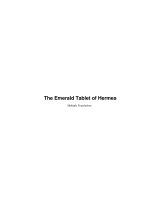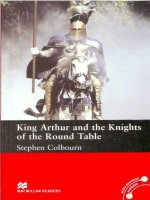The periodic table
Bạn đang xem bản rút gọn của tài liệu. Xem và tải ngay bản đầy đủ của tài liệu tại đây (20.92 MB, 683 trang )
svdinesh
svdinesh
www.pdfgrip.com
svdinesh
www.pdfgrip.com
New York ã London
â 2014 Paul Parsons and Gail Dixon. All illustrations by M ark
Franklin
All rights reserved. No part of this book may be reproduced in any
form or by any electronic or mechanical means, including
information storage and retrieval systems, without permission in
writing from the publisher, except by reviewers, who may quote
brief passages in a review. Scanning, uploading, and electronic
distribution of this book or the facilitation of the same without the
permission of the publisher is prohibited.
Please purchase only authorized electronic editions, and do not
participate in or encourage electronic piracy of copyrighted
materials. Your support of the author’s rights is appreciated.
Any member of educational institutions wishing to photocopy
part or all of the work for classroom use or anthology should send
inquiries to Permissions c/o Quercus Publishing Inc., 31 West 57th
Street, 6th Floor, New York, NY 10019, or to
ISBN 978-1-62365111-4
www.pdfgrip.com
Distributed in the United States and Canada by Random House
Publisher Services
c/o Random House, 1745 Broadway
New York, NY 10019
www.quercus.com
www.pdfgrip.com
www.pdfgrip.com
Contents
The Periodic Table
Introduction
Hydrogen
Helium
Lithium
Beryllium
Boron
Carbon
Nitrogen
Oxygen
Fluorine
Neon
Sodium
M agnesium
Aluminum
Silicon
Phosphorus
Sulfur
Chlorine
Argon
Potassium
Calcium
Scandium
www.pdfgrip.com
Titanium
Vanadium
Chromium
M anganese
Iron
Cobalt
Nickel
Copper
Zinc
Gallium
Germanium
Arsenic
Selenium
Bromine
Krypton
Rubidium
Strontium
Yttrium
Zirconium
Niobium
M olybdenum
Technetium
Ruthenium
Rhodium
Palladium
Silver
www.pdfgrip.com
Cadmium
Indium
Tin
Antimony
Tellurium
Iodine
Xenon
Caesium
Barium
Lanthanum
Cerium
Praseodymium
Neodymium
Promethium
Samarium
Europium
Gadolinium
Terbium
Dysprosium
Holmium
Erbium
Thulium
Ytterbium
Lutetium
Hafnium
Tantalum
www.pdfgrip.com
Tungsten
Rhenium
Osmium
Iridium
Platinum
Gold
M ercury
Thallium
Lead
Bismuth
Polonium
Astatine
Radon
Francium
Radium
Actinium
Thorium
Protactinium
Uranium
Neptunium
Plutonium
Americium
Curium
Berkelium
Californium
Einsteinium
www.pdfgrip.com
Fermium
The Transfermium Elements
Glossary
The Authors
www.pdfgrip.com
The Periodic Table
The periodic table shows the chemical elements ordered by atomic
number (number of protons in the nucleus), but arranged in rows
(periods) so that elements with similar chemistry occur in the same
vertical column (group). Here, elements with the same chemical and
physical properties are shown by the color categories identified in
the key at right. In general, members of each category also have a
similar chemical valency, a measure of the number of bonds an
element can form. Each element is represented by its chemical
symbol. Above the symbol is the element’s atomic number and
below is the element’s name.
www.pdfgrip.com
Element Categories
Alkali metals
Alkaline earth metals
Lanthanides
Actinides
Transition metals
www.pdfgrip.com
Post-transition metals
M etalloids
Other non-metals
Halogens
Noble gases
Unknown chemical properties
Alkali metals
This “group 1” of metals occupies the far-left column of the
periodic table. They are all soft, but solid metals at room
temperature, and are highly reactive—for example, when dropped
in water.
Elements Include: Li, Na, K, Rb, Cs, and Fr.
Alkaline earth metals
The alkaline earth metals are silver-white metals at room
temperature. The name is a term that refers to the naturally
occurring oxides of these elements. For example, lime is the alkaline
oxide of calcium.
Elements Include: Be, M g, Ca, Sr., Ba, and Ra.
Lanthanides
The lanthanide elements occupy a horizontal strip normally
appended at the foot of the periodic table. Named after lanthanum,
the first element in the
series, they are generally found in less
www.pdfgrip.com
common mineral rocks, such as monazite and bastnasite.
Elements Include: La, Ce, Pr, Nd, Pm, Sm, Eu, Gd, Tb, Dy, Ho,
Er, Tm, Yb, and Lu.
Actinides
The actinides fill the second horizontal strip at the foot of the
table. Named after their first element, actinium, they are all highly
radioactive. So much so, that natural reserves of many of these
elements have decayed away to nothing.
Elements Include: Ac, Th, Pa, U, Np, Pu, Am, Cm, Bk, Cf, Es,
Fm, M d, No, and Lr.
Transition metals
The transition metals occupy a broad swathe in the center of the
periodic table. They are harder than the alkali metals, less reactive
and are generally good conductors of both heat and electrical
current.
Elements Include: Sc, Ti, V, Cr, M n, Fe, Co, Ni, Cu, Zn, Y, Zr,
Nb, M o, Tc, Ru, Rh, Pd, Ag, Cd, Hf, Ta, W, Re, Os, Ir, Pt, Au,
Hg, Rf, Db, Sg, Bh, Hs, and Cn.
Post-transition metals
Lying in a triangular region to the right of the transition metals, the
post-transition metals are soft metals that mostly have low melting
and boiling points. They also include mercury, which is liquid at
www.pdfgrip.com
room temperature.
Elements Include: Al, Ga, In, Sn, Ti, Pb, and Bi.
Metalloids
The metalloid elements form a line between the metals and nonmetals in the periodic table. Their electrical conductivity is
intermediate between the two groups, leading to their use in
semiconductor electronics.
Elements Include: B, Si, Ge, As, Sb, Te, and Po.
Other non-metals
In addition to halogens and noble gases, there are other elements
that are simply classified as “other non-metals.” They display a
wide range of chemical properties and reactivities. They have high
ionization energies and electronegativities, and are generally poor
conductors of heat and electricity. M ost non-metals have the
ability to gain electrons easily. They have lower melting points,
boiling points and densities than the metal elements.
Elements Include: H, C, N, O, P, S, and Se.
Halogens
The halogens, known as group 17, are the only group to contain all
three principal states of matter at room temperature: gas (fluorine
and chlorine), liquid (bromine) and solid (iodine and astatine)—all
non-metals.
www.pdfgrip.com
Elements Include: F, Cl, Br., I, and At.
Noble gases
The noble gases are non-metals occupying group 18 of the table.
They are all gaseous at room temperature and share the properties
of being colorless, odorless and unreactive. Including neon, argon
and xenon, they have applications in lighting and welding.
Elements Include: He, Ne, Ar, Kr, Xe, and Rn.
Unknown chemical properties
This is a label reserved for elements that can only be manufactured
in a laboratory. Very often, only minute quantities of such
elements have been created—making it impossible to ascertain their
exact chemical classification.
Elements Include: M t, Ds, Rg, Uut, Fl, Uup, Lv, Uus, and Uuo.
www.pdfgrip.com
Introduction
In the early 1860s, a Russian chemist working at St. Petersburg
State University came up with an idea that would overturn our
understanding of the chemical world. Dmitri M endeleev put
forward the idea of representing all of the known chemical elements
in a table, according to their composition and properties. This
insight not only enabled him to predict the properties of as-yet
undiscovered elements, but would also shape the course of
chemical research for evermore.
M endeleev was fascinated by the chemical elements. Elements
are the fundamental building blocks of chemistry—chemical
substances that can exist as individual atoms (as opposed to more
complex chemical “compounds,” the smallest units of which—
molecules—are made by joining atoms of different elements
together).
M endeleev wondered if there was any way to order the elements
according to their properties. He set about listing all the known
elements (there were 62 of them at the time) by what’s known as
their “atomic mass number.” An atom consists of electrically
neutral neutron particles and positively charged protons clustered
tightly into a central nucleus, around which orbits a cloud of
negatively charged electrons. The mass of the electron particles is
so small compared to the others that it’s usually ignored. The
neutrons and protons, however, are heavier; these particles weigh
www.pdfgrip.com
about the same as each other. Counting up the total number of
neutrons and protons in an atom’s nucleus yields a figure known as
the atom’s “atomic mass number.”
M endeleev arranged the elements in a long line, left to right, in
order of their atomic mass. It was then that he noticed something
strange: if he chopped this linear sequence into strips and arranged
the strips into rows, to make a table, each column in the table
tended to contain elements with similar properties. His left-hand
column, for example, contained sodium, lithium and potassium—all
of which are solids at room temperature, tarnish quickly and react
violently with water. Because of this similarity, he referred to the
columns of the table as “groups” of elements, while the repetition
of properties led him to name the rows “periods.” He published
his “periodic table” in 1869.
M endeleev firmly believed that elements should be grouped
according to their properties. So much so, he made occasional
tweaks to his table, shifting elements on by a column or two to
place them in a group with other, more similar, elements. Doing so
inevitably left gaps. As it turned out, though, these only served to
reinforce the table’s validity—by making it testable. M endeleev
asserted that the gaps corresponded to elements that were yet to
be discovered. For example, arsenic should have occupied the slot
in period 4, group 13. But M endeleev believed it better fitted with
the properties of elements in group 15—which was where he duly
placed it. Sure enough, new elements (gallium and germanium) were
later discovered that filled the missing slots in groups 13 and 14,
www.pdfgrip.com
and fitted the properties of those groups perfectly.
In places, M endeleev was so convinced that elements should be
grouped by their properties that he even broke the rule of ordering
by atomic mass. In so doing, he uncovered the true principle by
which the elements are arranged—not by their atomic mass, but by
a new property called “atomic number.” Whereas atomic mass is
the total number of neutrons plus protons in the nucleus, atomic
number is determined just by the number of protons it contains.
Because protons each carry unit electric charge, atomic number is
essentially a measure of the charge on the nucleus, as would be
proven in 1913 by the British physicist, Henry M oseley. Atomic
number also turns out to be equal to the total number of negatively
charged electrons orbiting around the nucleus—making the atom’s
overall net charge zero. An element can be uniquely specified by its
atomic number—for example, carbon is synonymous with
“element 6” and plutonium is “element 94.”
M oseley’s analysis enabled chemists to refine the table further
and reveal more gaps, which suggested that there were more new
elements waiting to be discovered, with atomic numbers 43, 61, 72
and 75. Scientists subsequently found these elements—now
known as technetium, promethium, hafnium and rhenium,
respectively.
Despite M oseley’s confirmation of the order of the chemical
elements, there was still no real explanation for their periodic
properties—why the elements in each group were so similar. It
wasn’t long, though, before the answer to that question would be
www.pdfgrip.com
discovered via an emerging branch of science known as quantum
theory, which gave physicists new insights into the way subatomic
particles interact with one another.
When two substances react chemically, what’s actually
happening is that atoms and molecules of the substances are
exchanging and sharing their electrons. Quantum theory determines
the behavior of electrons. It revealed that the electrons in an atom
are organized into a number of levels, also known as “shells,” each
of which can accommodate a fixed number of electron particles. As
you go from one element to the next, and atomic number increases,
each shell gradually fills up—until it’s full and the process repeats.
Each of M endeleev’s periods corresponds to the filling of an
electron shell—each group has the same number of electrons in its
outer “valence” shell, which is the principal determinant of
chemical behavior. This is what gives the elements in the same
group their similar properties.
Not all electron shells in an atom can hold the same number of
electrons. The innermost level, for example, can hold just two; it is
this that explains the large gap at the top of the periodic table,
where hydrogen (with just one electron in the valence shell)
occupies the far left-hand column (group 1) but helium, with just
one extra electron, is in the far right column (group 18) amongst
other elements that have a full valence shell. The similar gaps on
periods 2 and 3 arise for the same reason. Conversely, the outer
shells can hold an inordinately large number of electrons, which
accounts for the existence of the lanthanide and actinide sequences
www.pdfgrip.com
—horizontal strips of elements that have been clipped out of the
main body of the table and appended at the bottom for neatness.
Although every atom of a given chemical element has a fixed
number of protons in its nucleus, the number of neutrons can vary.
Atoms with different numbers of neutrons are known as
“isotopes”—different isotopes of the same element generally have
the same chemistry but different nuclear properties, such as halflife (see Glossary). Other differences can occur from the way
atoms are arranged in a substance. Pure carbon, for example, can
take the form of soot, graphite and diamond. Such different forms
of a chemical element are known as “allotropes.”
In the text that follows, we meet all the chemical elements that
have been discovered so far (there are 118 of them). Each of the
first 100 has its own section. The heavier “transfermium” elements
(of which there are 18 known beyond element 100) are rarer and
have few applications, and so are detailed in a single consolidated
section at the back of the book.
www.pdfgrip.com
Hydrogen
Atomic number: 1
Category: non-metal
Atomic weight: 1.00794
Melting point: -259 °C (-434 °F)
Color: n/a
Boiling point: -253 °C (-423 °F)
Phase: gas
Crystal structure: n/a
www.pdfgrip.com
Hydrogen is the number one element of the periodic table and earns
this status for a range of reasons: along with helium and lithium, it
was one of the first three elements produced during the Big Bang; it
is the most abundant element in the universe, accounting for 88
percent of all atoms; and it is the lightest of all the elements, with
only one proton (which is why it is number 1 in the periodic table)
and one electron.
Hydrogen is life-giving in a variety of ways. It is the fuel that
keeps our Sun and other stars burning; every time you sunbathe or
watch the beauty of a glowing sunset, you are enjoying the result
of a massive nuclear reaction. At the Sun’s core, the temperature is
around 15 million °C (27 million °F) and the density is 200
kilograms per liter (250 lbs per pint). In such conditions, hydrogen
will begin to “burn” in a nuclear process and form helium nuclei,
emitting huge amounts of energy.
At standard temperature and pressure, hydrogen is a colorless
and odorless gas that exists in the diatomic form H2 (“diatomic”
meaning that it consists of two atoms). In this form, hydrogen is
highly combustible and
readily forms compounds with other
www.pdfgrip.com
elements. Combined with oxygen, hydrogen forms the water that
fills the seas, rivers, lakes and clouds. Allied with carbon, it helps
to bond the cells of living beings.
Hydrogen is also abundant in the Earth’s crust, in the
hydrocarbons that have been formed from decaying organisms.
These have become our modern-day fuels, such as crude oil and
natural gas. Now scientists believe that hydrocarbons may also be
formed in the deep Earth, from methane that’s subjected to extreme
pressures and temperatures.
Hydrogen is a key element in acids and it was this aspect of its
chemistry that led to its discovery. In 1766, Henry Cavendish, a
wealthy British man with an interest in science, observed bubbles
of gas rising from a reaction of iron filings in dilute sulfuric acid. He
collected the gas and found it to be highly flammable and very light:
qualities that made the gas seem unusual to Cavendish. He was also
the first person to prove that when hydrogen burned it formed
water, showing that water could be made from another substance
and thus disproving Aristotle’s theory that there were four basic
elements, of which water was one.
www.pdfgrip.com
www.pdfgrip.com









